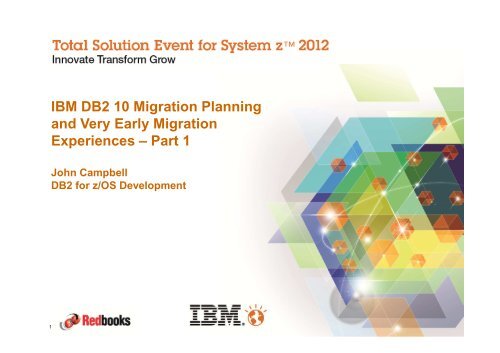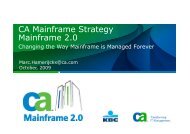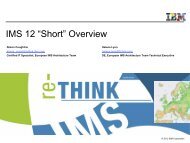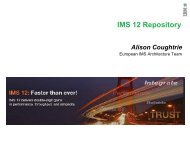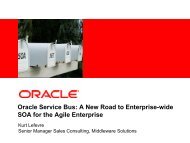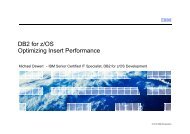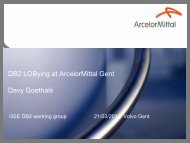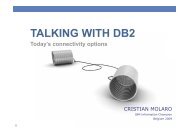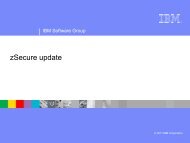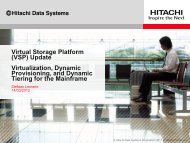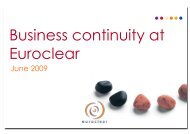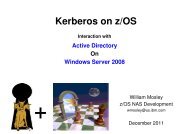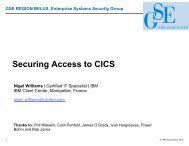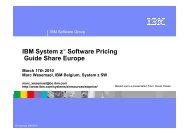IBM DB2 10 Migration Planning and Very Early ... - GSE Belux
IBM DB2 10 Migration Planning and Very Early ... - GSE Belux
IBM DB2 10 Migration Planning and Very Early ... - GSE Belux
You also want an ePaper? Increase the reach of your titles
YUMPU automatically turns print PDFs into web optimized ePapers that Google loves.
<strong>IBM</strong> <strong>DB2</strong> <strong>10</strong> <strong>Migration</strong> <strong>Planning</strong><br />
<strong>and</strong> <strong>Very</strong> <strong>Early</strong> <strong>Migration</strong><br />
Experiences – Part 1<br />
John Campbell<br />
<strong>DB2</strong> for z/OS Development<br />
1<br />
© 2012 <strong>IBM</strong> Corporation
2<br />
Title:<br />
PTF UK76697 (APAR PM5<strong>10</strong>93) is required for <strong>DB2</strong> <strong>10</strong> for z/OS NFM (New Function Mode) customers executing data<br />
recovery in a Data Sharing environment.<br />
Abstract:<br />
PTF UK76697 (APAR PM5<strong>10</strong>93) is required for <strong>DB2</strong> <strong>10</strong> for z/OS NFM (New Function Mode) customers executing data<br />
recovery in a Data Sharing environment.<br />
Description:<br />
<strong>IBM</strong> has become aware of potential data loss when executing data recovery in a <strong>DB2</strong> <strong>10</strong> Data Sharing environment.<br />
The problem is related to Fast Log Apply processing when LRSN values are used for log record sequencing <strong>and</strong> may result<br />
in some log records not being processed when duplicate LRSN values are encountered. This situation applies to the<br />
RECOVER <strong>and</strong> RESTORE SYSTEM utilities <strong>and</strong> LPL <strong>and</strong> GRECP recovery. The REORG utility <strong>and</strong> <strong>DB2</strong> restart<br />
processing are not exposed to this issue.<br />
Possible symptoms include ABEND04E RC00C90<strong>10</strong>2 DSNIBHRE:0C22 accompanied by MSGDSNI012I PAGE<br />
LOGICALLY BROKEN or other consistency errors during log apply. Other abends or errors may be encountered following<br />
log apply processing, including errors reported by CHECK INDEX or CHECK DATA.<br />
Recommended Action(s):<br />
It is recommended that all <strong>DB2</strong> <strong>10</strong> for z/OS data sharing customers apply PTF UK76697 as soon as possible. Customers<br />
planning to migrate to <strong>DB2</strong> <strong>10</strong> NFM should ensure that UK76697 is applied before they do so. The corrective maintenance<br />
can be applied incrementally across members of a data sharing group. A group wide restart is not required.<br />
Fast Log Apply processing may be disabled to prevent further exposure to this problem before UK76697 can be applied.<br />
The process for doing so is as follows, <strong>and</strong> should be repeated for each subsystem:<br />
– .Edit macro DSN6SPRC in the SDSNMACS library.<br />
– .Change &SPRMFLB SETC '<strong>10</strong>' to &SPRMFLB SETC '0'.<br />
– .Run job DSNTIJUZ to reassemble <strong>and</strong> relink the new zparm.<br />
– .Recycle <strong>DB2</strong> to load the new zparm.<br />
Refer to the cover letter for UK76697 for further details regarding this issue.<br />
© 2012 <strong>IBM</strong> Corporation
PM56535 <strong>DB2</strong> <strong>10</strong> for z/OS NFM users using UTS that was created in V9 may encounter broken pages during cross<br />
partition update cleanup operations in DSNIKDEF.<br />
Correction<br />
Notes<br />
PTF UK76352 is available<br />
There is no actual data loss, however, the potential exists for corrupted data pages <strong>and</strong> orphan pointer records.<br />
Customers wishing to proactively check for this condition can use DSN1COPY with the CHECK option, which<br />
runs offline <strong>and</strong> is non-disruptive.<br />
However, the <strong>IBM</strong> COPY utility would automatically detect corrupted data pages, so a normal backup cycle<br />
should be sufficient to validate data.<br />
If <strong>DB2</strong> detects a problem, then the page may be marked broken. This can be reset by REPAIR using REPAIR<br />
LOCATE db.ts PAGE(nnnn) RESET.<br />
The <strong>IBM</strong> REORG utility will correct the page corruption.<br />
PM58114 <strong>DB2</strong> for z/OS V9 or <strong>DB2</strong> <strong>10</strong> for z/OS NFM uses concurrent "LOCK table" <strong>and</strong> "INSERT" on a PBG<br />
TABLESPACE may cause page regression.<br />
Correction<br />
Notes<br />
APAR remains open. Corrective relief, AM58114B, is available from <strong>DB2</strong> Technical Support<br />
Latent data corruption may exist as a result of page regression.<br />
CHECK INDEX <strong>and</strong> CHECK DATA are the best tools for attempting to proactively detect the situation.<br />
DSN1LOGP with the CHECK parm may also be used.<br />
If any inconsistencies are encountered then they should be corrected, e.g. by using REORG or REBUILD INDEX<br />
3<br />
© 2012 <strong>IBM</strong> Corporation
PM45458 <strong>DB2</strong> <strong>10</strong> for z/OS NFM users using UTS may receive ABEND04E RC00C90<strong>10</strong>5 at DSNIREPR:0C27 when<br />
processing an UPDATE on a pointer record.<br />
Correction PTF UK45458 is available (RSU 11<strong>10</strong>).<br />
Notes Latent data page corruption is possible as a result of this problem.<br />
DSN1COPY CHECK or the <strong>IBM</strong> COPY utility can be used to identify corrupted pages.<br />
If found to exist, manual REPAIR by <strong>IBM</strong> Support may be required, <strong>and</strong> potentially a REORG.<br />
PM55070 <strong>DB2</strong> <strong>10</strong> for z/OS NFM users of UTS table spaces defined for row level locking that are performing SQL<br />
UPDATE may see broken pages during backout processing.<br />
Correction<br />
APAR remains open. Corrective relief, AM55070, is available from <strong>DB2</strong> Technical Suppor<br />
Notes<br />
This is a problem specific to freespace reuse <strong>and</strong> later rollback. There should be no latent data corruption. i.e.<br />
the only way a customer would have data corruption is if they actually encountered an abend during rollback, in which case<br />
the page would be marked broken <strong>and</strong> they should report the problem to <strong>IBM</strong> Support. There is no need for customers to<br />
proactively check for problems. If such is desired, then any utility such as DSN1COPY, REORG, COPY or any application<br />
access would report a page marked broken.Then they should be corrected, e.g. by using REORG or REBUILD INDEX<br />
4<br />
© 2012 <strong>IBM</strong> Corporation
Notices<br />
This information was developed for products <strong>and</strong> services offered in the U.S.A.<br />
Note to U.S. Government Users Restricted Rights — Use, duplication or disclosure restricted by GSA ADP Schedule Contract with <strong>IBM</strong> Corp.<br />
<strong>IBM</strong> may not offer the products, services, or features discussed in this document in other countries. Consult your local <strong>IBM</strong> representative for information on the products <strong>and</strong> services<br />
currently available in your area. Any reference to an <strong>IBM</strong> product, program, or service is not intended to state or imply that only that <strong>IBM</strong> product, program, or service may be used.<br />
Any functionally equivalent product, program, or service that does not infringe any <strong>IBM</strong> intellectual property right may be used instead. However, it is the user's responsibility to<br />
evaluate <strong>and</strong> verify the operation of any non-<strong>IBM</strong> product, program, or service.<br />
<strong>IBM</strong> may have patents or pending patent applications covering subject matter described in this document. The furnishing of this document does not give you any license to these<br />
patents. You can send license inquiries, in writing, to: <strong>IBM</strong> Director of Licensing, <strong>IBM</strong> Corporation, North Castle Drive Armonk, NY <strong>10</strong>504-1785 U.S.A.<br />
The following paragraph does not apply to the United Kingdom or any other country where such provisions are inconsistent with local law: INTERNATIONAL BUSINESS MACHINES<br />
CORPORATION PROVIDES THIS PUBLICATION "AS IS" WITHOUT WARRANTY OF ANY KIND, EITHER EXPRESS OR IMPLIED, INCLUDING, BUT NOT LIMITED TO, THE<br />
IMPLIED WARRANTIES OF NON-INFRINGEMENT, MERCHANTABILITY OR FITNESS FOR A PARTICULAR PURPOSE. Some states do not allow disclaimer of express or implied<br />
warranties in certain transactions, therefore, this statement may not apply to you.<br />
This information could include technical inaccuracies or typographical errors. Changes are periodically made to the information herein; these changes will be incorporated in new<br />
editions of the publication. <strong>IBM</strong> may make improvements <strong>and</strong>/or changes in the product(s) <strong>and</strong>/or the program(s) described in this publication at any time without notice.<br />
Any references in this information to non-<strong>IBM</strong> Web sites are provided for convenience only <strong>and</strong> do not in any manner serve as an endorsement of those Web sites. The materials at<br />
those Web sites are not part of the materials for this <strong>IBM</strong> product <strong>and</strong> use of those Web sites is at your own risk.<br />
<strong>IBM</strong> may use or distribute any of the information you supply in any way it believes appropriate without incurring any obligation to you.<br />
Information concerning non-<strong>IBM</strong> products was obtained from the suppliers of those products, their published announcements or other publicly available sources. <strong>IBM</strong> has not tested<br />
those products <strong>and</strong> cannot confirm the accuracy of performance, compatibility or any other claims related to non-<strong>IBM</strong> products. Questions on the capabilities of non-<strong>IBM</strong> products<br />
should be addressed to the suppliers of those products.<br />
This information contains examples of data <strong>and</strong> reports used in daily business operations. To illustrate them as completely as possible, the examples include the names of individuals,<br />
companies, br<strong>and</strong>s, <strong>and</strong> products. All of these names are fictitious <strong>and</strong> any similarity to the names <strong>and</strong> addresses used by an actual business enterprise is entirely coincidental.<br />
Copyright License:<br />
This information contains sample application programs in source language, which illustrates programming techniques on various operating platforms. You may copy, modify, <strong>and</strong><br />
distribute these sample programs in any form without payment to <strong>IBM</strong>, for the purposes of developing, using, marketing or distributing application programs conforming to the<br />
application programming interface for the operating platform for which the sample programs are written. These examples have not been thoroughly tested under all conditions. <strong>IBM</strong>,<br />
therefore, cannot guarantee or imply reliability, serviceability, or function of these programs. You may copy, modify, <strong>and</strong> distribute these sample programs in any form without payment<br />
to <strong>IBM</strong> for the purposes of developing, using, marketing, or distributing application programs conforming to <strong>IBM</strong>'s application programming interfaces.<br />
5<br />
© 2012 <strong>IBM</strong> Corporation
Trademarks<br />
This presentation contains trade-marked <strong>IBM</strong> products <strong>and</strong> technologies. Refer to the<br />
following Web site:<br />
http://www.ibm.com/legal/copytrade.shtml<br />
6<br />
© 2012 <strong>IBM</strong> Corporation
Objectives<br />
Share lessons learned, surprises, pitfalls<br />
Provide hints <strong>and</strong> tips<br />
Address some myths<br />
Provide additional planning information<br />
Provide usage guidelines <strong>and</strong> positioning on new enhancements<br />
7<br />
© 2011 <strong>IBM</strong> Corporation
Agenda<br />
Keys to customer migration success<br />
Performance <strong>and</strong> Scalability<br />
BIND, REBIND <strong>and</strong> EXPLAIN<br />
Availability<br />
<strong>Migration</strong> <strong>Planning</strong><br />
Removal of DDF Private Protocol<br />
Security Considerations when removing DDF Private Protocol<br />
Other<br />
Summary<br />
8<br />
© 2011 <strong>IBM</strong> Corporation
Keys to customer migration success<br />
1. Plan for continual application of preventative service<br />
– Need to stay more current on HIPERs at this stage in the release take up cycle<br />
– Apply preventative service every 3 months<br />
• Two “major” <strong>and</strong> two “minor” releases<br />
• Refresh of the base every 6 months (“major”)<br />
• Each base should be based on latest quarterly RSU as opposed use of PUT<br />
• In addition, two ‘minor’ packages covering HIPERs <strong>and</strong> PEs in between time<br />
– Augment by exploiting Enhanced HOLDDATA on a weekly basis before<br />
production cutover <strong>and</strong> continue thereafter<br />
• Identify <strong>and</strong> pull all applicable HIPERs <strong>and</strong> PE fixes<br />
• Expedite the most critical PTFs into production<br />
2. Perform application regression <strong>and</strong> stress testing is the best way to keep<br />
‘fires’ away from production<br />
3. Build a realistic project plan<br />
– Avoid crash project<br />
– Allow contingency for ‘bumps in the road’<br />
– Involve applications teams early<br />
• Investigation of incompatible changes <strong>and</strong> fix up<br />
• Testing<br />
9<br />
© 2011 <strong>IBM</strong> Corporation
CST <strong>and</strong> RSU example<br />
CST4Q<strong>10</strong><br />
CST1Q11<br />
RSU<strong>10</strong>12<br />
RSU1<strong>10</strong>1<br />
RSU1<strong>10</strong>2<br />
RSU1<strong>10</strong>3<br />
All service through end<br />
Sept 20<strong>10</strong> not already<br />
marked RSU<br />
All service through end<br />
Dec 20<strong>10</strong> not already<br />
marked RSU<br />
+<br />
H&PE<br />
H&PE<br />
+<br />
H&PE<br />
through end Dec 20<strong>10</strong><br />
through end Jan 2011<br />
H&PE<br />
through end Nov 20<strong>10</strong><br />
through end Feb 2011<br />
Available at the beginning<br />
of January 2011<br />
Available at the beginning<br />
of February 2011<br />
Available at the beginning<br />
of March 2011<br />
Available at the beginning<br />
of April 2011<br />
Base: Sep 20<strong>10</strong><br />
Base: Sep 20<strong>10</strong><br />
Base: Sep 20<strong>10</strong><br />
Base: Dec 20<strong>10</strong><br />
H&PE: Nov 20<strong>10</strong><br />
H&PE: Dec 20<strong>10</strong><br />
H&PE: Jan 2011<br />
H&PE: Feb 2011<br />
H&PE = HIPER/Security/Integrity/Pervasive PTFs + PE resolution (<strong>and</strong> associated requisites <strong>and</strong> supersedes)<br />
<strong>10</strong><br />
© 2011 <strong>IBM</strong> Corporation
Performance <strong>and</strong> Scalability<br />
Many opportunities for price/performance (cost) improvements<br />
– Major theme of this release<br />
– Most welcome to our customers<br />
Customers intimidated by the marketing noise about improved performance<br />
– Expectation of their CIO<br />
– For some of their workloads not seeing improvements in CPU <strong>and</strong> elapsed time<br />
– Conversely see big improvements for certain workloads<br />
– Small workloads can skew expectations on savings<br />
– Some measurements <strong>and</strong> quotes are insanely positive<br />
• Should be ignored<br />
– How to extrapolate <strong>and</strong> estimate for production mixed workload?<br />
• Estimation with accuracy <strong>and</strong> high confidence not practical<br />
• Benchmarking effort would be required<br />
<strong>Very</strong> important to correctly level set customer performance expectations<br />
Customers should not spend any performance benefits until they see them<br />
11<br />
© 2011 <strong>IBM</strong> Corporation
Performance <strong>and</strong> Scalability …<br />
Assumes no major access path regressions<br />
On Day 1 in production in CM without any changes (e.g., no rebind, no use<br />
of 1MB page size) there may be customers who see zero % improvement<br />
<strong>and</strong> even some will see degradation<br />
– Why? SPROCs disabled, puffing of run time structures for migrated packages<br />
from V8 or V9, etc<br />
To maximise the performance improvements must:<br />
– REBIND static SQL packages<br />
– Use PGFIX=YES bufferpools with sufficient 1MB real storage page frames to<br />
<strong>10</strong>0% fully back the requirement from PGFIX=YES bufferpools<br />
Seeing 0-<strong>10</strong>% improvement after REBIND <strong>and</strong> use of 1MB real storage<br />
frames<br />
Need to look at total CPU resource consumption picture across<br />
– Acctg Class 2 TCB Time (Accounting Trace)<br />
– <strong>DB2</strong> System Address spaces (Statistics Trace)<br />
12<br />
© 2011 <strong>IBM</strong> Corporation
Performance <strong>and</strong> Scalability …<br />
Customers should expect to see some increase in real storage<br />
consumption (<strong>10</strong>-30%)<br />
– Must also factor in MAXSPACE requirement for <strong>DB2</strong> dumps (approx 16GB)<br />
• Avoid very long dump capture times <strong>and</strong> bad system performance<br />
• Critical for V<strong>10</strong> serviceability<br />
13<br />
© 2011 <strong>IBM</strong> Corporation
Performance <strong>and</strong> Scalability …<br />
The 0-<strong>10</strong>% CPU reduction is based on the <strong>DB2</strong> portion of a given<br />
application workload<br />
Customer value driven on how sub-capacity workload licensing works<br />
– Based on 4-hour rolling average MSU utilisation<br />
– Highest rolling average figure for each month used to calculate software<br />
charges for all MLC products (<strong>IBM</strong> <strong>and</strong> non-<strong>IBM</strong>)<br />
– Provided <strong>DB2</strong> forms a significant component of the total MSU usage during<br />
peak period, any MSU savings will translate directly to MLC savings<br />
– Typically this is the online day - mid morning <strong>and</strong> mid afternoon<br />
– So for example - this may be driven by CICS-<strong>DB2</strong> workload where the <strong>DB2</strong><br />
portion of the workload only represents 40-60% of the total path length<br />
– So the 0-<strong>10</strong>% may represent only 0 to 6% (i.e., needs to be discounted)<br />
– Investigate how much CPU is used in the 4-hour period for <strong>DB2</strong> work (SQL)<br />
– Evaluate V<strong>10</strong> price b<strong>and</strong>s under WLC pricing vs. V<strong>10</strong> MSU savings<br />
– Factor in the impact on overall z/OS software stack cost reduction<br />
– z/OS, CICS, MQ<br />
14<br />
© 2011 <strong>IBM</strong> Corporation
Performance <strong>and</strong> Scalability …<br />
Sub capacity pricing<br />
Chart courtesy of Cristian Molaro, taken from White Paper: Getting the financial benefits of <strong>DB2</strong> <strong>10</strong> for z/OS<br />
15<br />
© 2011 <strong>IBM</strong> Corporation
Performance <strong>and</strong> Scalability …<br />
Opportunities for additional price/performance improvements driven by<br />
DBM1 31-bit VSCR supported by additional real storage include<br />
– More use of persistent threads with selective use of RELEASE(DEALLOCATE)<br />
• High Performance DBATs<br />
• CICS Protected ENTRY Threads<br />
• CICS Unprotected ENTRY Threads with queuing<br />
• Typical savings 0-<strong>10</strong>%, may be more<br />
– Increasing MAXKEEPD to improve Local Dynamic Statement Cache hit ratio<br />
<strong>and</strong> reduce the number of short prepares<br />
– Sysplex/Data sharing Group consolidation<br />
• So for example, 8-way to 4-way<br />
• Reduced cost of data sharing<br />
<strong>Very</strong> important to correctly level set customer performance expectations<br />
Customers should not spend any performance benefits until they see them<br />
16<br />
© 2011 <strong>IBM</strong> Corporation
Performance <strong>and</strong> Scalability …<br />
Workload<br />
CICS online transactions<br />
Customer Results<br />
Approx. 7% CPU reduction in <strong>DB2</strong> <strong>10</strong> CM after REBIND, additional reduction<br />
when 1MB page frames are used for selective buffer pools<br />
CICS online transactions Approx <strong>10</strong>% CPU reduction from <strong>DB2</strong> 9<br />
CICS online transactions<br />
Approx 5% CPU reduction from <strong>DB2</strong> V8<br />
CICS online transactions<br />
<strong>10</strong>+% CPU increase<br />
Distributed Concurrent Insert<br />
Data sharing heavy<br />
concurrent insert<br />
Queries<br />
Batch<br />
50% <strong>DB2</strong> elapsed time reduction, 15% chargeable CPU reduction after<br />
enabling high performance DBAT<br />
38% CPU reduction<br />
Average CPU reduction 28% from V8 to <strong>DB2</strong> <strong>10</strong> NFM<br />
Overall 20-25% CPU reduction after rebind packages<br />
17 © 2011 <strong>IBM</strong> Corporation 17
Performance <strong>and</strong> Scalability …<br />
Workload<br />
Multi row insert (data sharing)<br />
Parallel Index Update<br />
Inline LOB<br />
Include Index<br />
Hash Access<br />
Customer Results<br />
33% CPU reduction from V9, 4x improvement from V8 due to LRSN spin<br />
reduction<br />
30-40% Elapsed time improvement with class 2 CPU time reduction<br />
SELECT LOB shows 80% CPU reduction<br />
17% CPU reduction in insert after using INCLUDE INDEX<br />
20-30% CPU reduction in r<strong>and</strong>om access<br />
16% CPU reduction comparing Hash Access <strong>and</strong> Index-data access.<br />
5% CPU reduction comparing Hash against Index only access<br />
Further improvements delivered late in the beta program.<br />
18 © 2011 <strong>IBM</strong> Corporation 18
Performance <strong>and</strong> Scalability …<br />
Measurements of <strong>IBM</strong> Relational<br />
Warehouse Workload (IRWW) with<br />
data sharing<br />
– Base: <strong>DB2</strong> 9 NFM REBIND with<br />
PLANMGMT EXTENDED<br />
– <strong>DB2</strong> 9 NFM <strong>DB2</strong> <strong>10</strong> CM without<br />
REBIND showed 1.3% CPU reduction<br />
– <strong>DB2</strong> <strong>10</strong> CM REBIND with same access<br />
path showed 4.8% CPU reduction<br />
– <strong>DB2</strong> <strong>10</strong> NFM brought 5.1% CPU reduction<br />
– <strong>DB2</strong> <strong>10</strong> CM or NFM with RELEASE<br />
DEALLOCATE 12.6% CPU reduction from<br />
<strong>DB2</strong> 9<br />
14<br />
12<br />
<strong>10</strong><br />
8<br />
6<br />
4<br />
2<br />
0<br />
CM<br />
CM<br />
REBIND<br />
NFM<br />
DEALLOC<br />
19<br />
© 2011 <strong>IBM</strong> Corporation
Performance <strong>and</strong> Scalability …<br />
Query performance enhancements<br />
– No REBIND required for<br />
• Index list prefetch<br />
• INSERT index read I/O parallelism<br />
• Workfile spanned records<br />
• SQLPL performance<br />
• High performance DBATs<br />
• Inline LOBs<br />
20<br />
© 2011 <strong>IBM</strong> Corporation
Performance <strong>and</strong> Scalability …<br />
Query performance enhancements …<br />
– REBIND required for<br />
• Use of RELEASE(DEALLOCATE)<br />
• <strong>Early</strong> evaluation of residual predicates<br />
• IN-list improvements (new access method)<br />
• SQL pagination (new access method)<br />
• Query parallelism improvements<br />
• Index include columns<br />
• More aggressive view/table expression merge<br />
• Predicate evaluation enhancements<br />
• RID list overflow improvements<br />
– Execute RUNSTATS before REBIND<br />
• When coming from V8, to collect improved index statistics including CLUSTERRATIOF<br />
• When coming from V9, if do not already include the KEYCARD option of RUNSTATS<br />
21<br />
© 2011 <strong>IBM</strong> Corporation
Performance <strong>and</strong> Scalability …<br />
Potential for access path regression when using OPTIMIZE FOR 1 ROW<br />
– Used by customers as a hint to discourage use of sort or list prefetch<br />
– Sometimes applied as an installation SQL coding st<strong>and</strong>ard<br />
– <strong>DB2</strong> access path selection has always been cost based<br />
– V<strong>10</strong> ‘hammer’ change<br />
• Excludes the ‘sort’ access plan c<strong>and</strong>idates<br />
• Remaining ‘sort avoidance’ access plans compete on cost – lowest cost wins<br />
• If no ‘sort avoidance’ access plans, then ‘sort’ access plans remain <strong>and</strong> compete on<br />
cost<br />
– Seeing increasing evidence of access path regression when multiple c<strong>and</strong>idate<br />
indexes available e.g.,<br />
• <strong>DB2</strong> using alternate index with lower MATCHCOLS value because there is no sort<br />
– Solutions<br />
• Change application to code OPTIMIZE FOR 2 ROWS<br />
• Alter an existing index or create a new index that would support both sort avoidance<br />
<strong>and</strong> index matching (if predicates allow)<br />
• APAR PM56845 now open to provide option for OPTIMIZE FOR 1 ROW to allow sort<br />
access plans<br />
22<br />
© 2011 <strong>IBM</strong> Corporation
Performance <strong>and</strong> Scalability …<br />
Increase in <strong>DB2</strong> system address space CPU resource consumption<br />
– DBM1 SRB<br />
• More use of prefetch<br />
– Row level sequential detection <strong>and</strong> progressive prefetch<br />
– INSERT index read I/O parallelism<br />
– Index list prefetch when disorganised index<br />
– After BIND, more use of list prefetch<br />
• zIIP offload for prefetch <strong>and</strong> deferred write<br />
– Seeing 50-70% zIIP offload achieved<br />
– DBM1 TCB<br />
• Closing of high use CLOSE=YES datasets when hitting DSMAX because of stale list<br />
• See APAR PM56725 for this issue<br />
– MSTR TCB<br />
• Increase related to real storage monitoring which was introduced (APAR PM24723)<br />
• <strong>DB2</strong> is calling a z/OS RSM service for COUNTPAGES function which serialised the<br />
frame access with spin loop<br />
• CPU increase especially when multiple <strong>DB2</strong> subsystems running on the same LPAR<br />
• See z/OS APAR OA37821 <strong>and</strong> corresponding <strong>DB2</strong> APAR PM49816 for this issue<br />
23<br />
© 2011 <strong>IBM</strong> Corporation
Performance <strong>and</strong> Scalability …<br />
Bufferpool Page Classification<br />
– Sequential, dynamic, <strong>and</strong> list prefetch are all treated the same<br />
• Pages are marked sequential at the time they are prefetched<br />
– In V8<br />
• These pages were reclassified as r<strong>and</strong>om when subsequently touched via getpage<br />
– In V9 <strong>and</strong> V<strong>10</strong><br />
• None of them will be re-classified to r<strong>and</strong>om on a getpage<br />
CF utilisation issue<br />
– Root cause is the way GBP data in the CF is deleted in V<strong>10</strong><br />
– CF DELETE call option being invoked by V<strong>10</strong> deletes both data <strong>and</strong> directory<br />
entries in one CF call<br />
• But the code path used with name class mask requires more internal CFCC<br />
serialisation <strong>and</strong> can take longer<br />
– Results in significantly more re-drives of the DELETE requests observed with V<strong>10</strong><br />
– Increased volume of re-drives causes the significant increase in CF utilisation<br />
– See APAR PM51467 for this issue<br />
24<br />
© 2011 <strong>IBM</strong> Corporation
Performance <strong>and</strong> Scalability …<br />
<strong>DB2</strong> <strong>10</strong> <strong>and</strong> z196 synergy<br />
– Taking the general case, performance improvement from V9 to V<strong>10</strong> observed<br />
on z<strong>10</strong> processor should be in same range on z196 processor as long as they<br />
are measured on the same number of processors<br />
• Expectation is still in the 5-<strong>10</strong>% range<br />
– Apart from MIPs improvement, z196 provides<br />
• Higher cache hit ratio thus better scalability as number of processors per LPAR<br />
increases (more than 16 processors per LPAR)<br />
– V<strong>10</strong> performance on z196<br />
• Scales better with more processors per LPAR than z<strong>10</strong><br />
• Can run with higher number of concurrent threads<br />
– <strong>IBM</strong> measurement shows 20% ITR improvement from V9 (with a few<br />
benchmark specials) compared to V<strong>10</strong> on z196 80-way with IRWW-like<br />
workload<br />
• Measurement is extreme case<br />
• Will only apply to very high end customers<br />
• Not a general message<br />
– Why does V<strong>10</strong> run better on z196<br />
• Latch contention reductions, 1MB real storage page frame size, general path length<br />
25<br />
© 2011 <strong>IBM</strong> Corporation
Performance <strong>and</strong> Scalability …<br />
Use of 1MB size real storage page frames on z<strong>10</strong> <strong>and</strong> z196<br />
– Long term bufferpool page fix was introduced in V8 to reduce CPU<br />
• Many customers reluctant to use PGFIX=YES<br />
• Potential for real storage shortage because running too close to the edge of the<br />
amount of real storage provisioned<br />
• Customers do underst<strong>and</strong> the value, but it only applies for a few hours each day<br />
• But page fix is a long term decision<br />
• In most cases requires <strong>DB2</strong> recycle to change attribute<br />
• 75% cost reduction on real storage on z196 (USD1.5K vs. USD6K)<br />
26<br />
© 2011 <strong>IBM</strong> Corporation
Performance <strong>and</strong> Scalability …<br />
Use of 1MB size real storage page frames on z<strong>10</strong> <strong>and</strong> z196 …<br />
– Potential for reduced for CPU through less TLB misses<br />
– CPU reduction based on customer experience 0 to 6%<br />
– Buffer pools must be defined as PGFIX=YES to use 1MB size page frames<br />
– Must have sufficient total real storage to fully back the total <strong>DB2</strong> requirement<br />
– Involves partitioning real storage into 4KB <strong>and</strong> 1MB size page frames<br />
• Specified by LFAREA xx% in IEASYSnn parmlib member <strong>and</strong> only changeable by IPL<br />
• 1MB size page frames are non-pageable<br />
• If 1MB size page frames are overcommitted, <strong>DB2</strong> will use 4KB size page frames<br />
• Recommendation to add 5-<strong>10</strong>% to the size to allow for some growth <strong>and</strong> tuning<br />
– Must have both enough 4KB <strong>and</strong> enough 1MB size page frames<br />
– Do not use 1MB size real storage frames until running smoothly on V<strong>10</strong><br />
– Make sure any critical z/OS maintenance is applied before using 1MB size real<br />
storage page frames<br />
27<br />
© 2011 <strong>IBM</strong> Corporation
Performance <strong>and</strong> Scalability …<br />
Use of 1MB size real storage page frames on z<strong>10</strong> <strong>and</strong> z196 …<br />
– Useful comm<strong>and</strong>s<br />
• <strong>DB2</strong> -DISPLAY BUFFERPOOL(BP1) SERVICE=4<br />
– Useful comm<strong>and</strong> to find out how many 1MB size page frames are being used<br />
– Especially useful when running multiple <strong>DB2</strong> subsystems on the same LPAR<br />
– See DSNB999I message<br />
• MVS -DISPLAY VIRTSTOR,LFAREA<br />
– Show total LFAREA, allocation split across 4KB <strong>and</strong> 1MB size frames, what is available<br />
– See IAR019I message<br />
28<br />
© 2011 <strong>IBM</strong> Corporation
Performance <strong>and</strong> Scalability …<br />
Exceptions where CPU regression for very light OLTP transactions<br />
– Skinny packages with few simple SQL<br />
– Package allocation cost overrides benefit from SQL optimizations in V<strong>10</strong><br />
– APAR PM31614 may solve this by improving package allocation performance<br />
– Good c<strong>and</strong>idate for the use of persistent threads with<br />
RELEASE(DEALLOCATE) <strong>and</strong> will help compensate<br />
29<br />
© 2011 <strong>IBM</strong> Corporation
Performance <strong>and</strong> Scalability …<br />
DBM1 31-bit Virtual Storage Constraint Relief with 64-bit SQL run time<br />
V7 V8 V9 V<strong>10</strong><br />
16 ExaByte=2 64 Castout bfrs<br />
DBM1 address<br />
space<br />
2 GigaByte=2 31<br />
IRLM locks<br />
Castout bfrs<br />
Compression<br />
DBD Cache<br />
Global DSC<br />
Ridpool<br />
Sortpool<br />
DDF ctrl-blks<br />
SK-CT/PT<br />
+<br />
Castout bfrs<br />
Compression<br />
DBD Cache<br />
Global DSC<br />
Ridpool<br />
Sortpool<br />
CT/PT<br />
Thread<br />
+<br />
Castout bfrs<br />
Compression<br />
DBD Cache<br />
Global DSC<br />
Ridpool<br />
SK-CT/PT<br />
Sortpool<br />
Real storage<br />
All<br />
EDMPool<br />
Thread<br />
DSMAX<br />
CT/PT<br />
Thread<br />
DSMAX<br />
Pointer<br />
DSMAX<br />
Dataspaces<br />
CTHREAD+MAXDBAT=2000<br />
CTHREAD+MAXDBAT=20000<br />
practical limit ~a few hundreds ~a few thous<strong>and</strong>s<br />
30<br />
© 2011 <strong>IBM</strong> Corporation
Performance <strong>and</strong> Scalability …<br />
DBM1 31-bit Virtual Storage Constraint Relief with 64-bit SQL run time<br />
– Available in CM<br />
– Requirement to REBIND static SQL packages to accrue maximum benefit<br />
– <strong>Very</strong> good results achieved (up to 90% VSCR)<br />
– Have high degree of confidence that problem addressed<br />
• Real world proposition: 500 -> 2500-3000 threads plus<br />
– Limiting factors now on vertical scalability (# number of threads, thread storage<br />
footprint)<br />
• Amount of real storage provisioned on the LPAR<br />
• Log latch (LC19) contention<br />
• ESQA/ECSA (31-bit) storage<br />
31<br />
© 2011 <strong>IBM</strong> Corporation
Performance <strong>and</strong> Scalability …<br />
DBM1 31-bit Thread Storage V9 vs. V<strong>10</strong> – Initially but corrected prior to GA<br />
AVG THREAD FOOTPRINT1 (MB)<br />
4.5<br />
4<br />
V9 V<strong>10</strong> CM V<strong>10</strong> CM Rebind<br />
3.5<br />
3<br />
2.5<br />
2<br />
1.5<br />
1<br />
0.5<br />
0<br />
91 91 91 91 91 91 91 91 91 91 91 91 91 91 A1 A1 A1 A1 A1 A1 A1 A1 A1 A1 A1 A1 A1 A1 A1 A1 A1 A1 A1 A1 A1 A1 0 A1+A1+A1+ 0 A1+ 0 A1+<br />
EDM CT/PT (MB) EDM 25% FRAG AGL_USER (MB)<br />
32<br />
© 2011 <strong>IBM</strong> Corporation
Performance <strong>and</strong> Scalability …<br />
DBM1 31-bit Thread Storage V9 vs. V<strong>10</strong> – as at GA after Fix<br />
AVG THREAD FOOTPRINT1 (MB)<br />
4.5<br />
4<br />
V9<br />
V<strong>10</strong> CM<br />
V<strong>10</strong> CM with Fix<br />
3.5<br />
3<br />
2.5<br />
2<br />
1.5<br />
1<br />
0.5<br />
0<br />
91 91 91 91 A1 A1 A1 A1 A1 A1 A1 0 A1+UMA1+UMA1+UMA1+UMA1+UMA1+UMA1+UMA1+UMA1+UMA1+UMA1+UMA1+UM<br />
EDM CT/PT (MB) EDM 25% FRAG AGL_USER (MB)<br />
33<br />
© 2011 <strong>IBM</strong> Corporation
Performance <strong>and</strong> Scalability …<br />
DBM1 31-bit Virtual Storage Constraint Relief with 64-bit SQL run time<br />
– Major customer opportunities here for 31-bit VSCR <strong>and</strong> improved<br />
price/performance<br />
• Potential to reduce legacy OLTP transaction CPU cost through use of<br />
– More CICS protected ENTRY (persistent) threads<br />
– More use of RELEASE(DEALLOCATE) with next/existing persistent threads<br />
• Potential to reduce CPU for DRDA transactions by using High Performance DBAT<br />
– Must be using CMTSTAT=INACTIVE so that threads can be pooled <strong>and</strong> reused<br />
– Packages must be bound with RELEASE(DEALLOCATE) to get reuse for same connection<br />
– MODIFY DDF PKGREL(BNDOPT) must also be in effect<br />
– Do not to overuse RELEASE(DEALLOCATE) on packages<br />
> Will drive up the MAXDBAT requirement<br />
• Potential to reduce CPU when using KEEPDYNAMIC(YES) e.g., SAP<br />
– Increase MAXKEEPD to improve Local Dynamic Cache Hit Ratio <strong>and</strong> reduce the number of<br />
short prepares<br />
– Must provision additional real storage to back the requirement for each<br />
opportunity<br />
34<br />
© 2011 <strong>IBM</strong> Corporation
Performance <strong>and</strong> Scalability …<br />
DBM1 31-bit Virtual Storage Constraint Relief with 64-bit SQL run time<br />
– More persistent threads with RELEASE(DEALLOCATE) is also trade off with<br />
BIND/REBIND <strong>and</strong> DDL concurrency<br />
– For RELEASE(DEALLOCATE) some locks are held beyond commit until<br />
thread termination<br />
• Mass delete locks (SQL DELETE without WHERE clause)<br />
• Gross level lock acquired on behalf of a SQL LOCK TABLE<br />
• Note: no longer a problem for gross level lock acquired by lock escalation<br />
– CICS-<strong>DB2</strong> accounting for cost of thread create <strong>and</strong> terminate, or avoidance<br />
thereof<br />
• CICS uses the L8 TCB to access <strong>DB2</strong> irrespective of whether the application is thread<br />
safe or not<br />
• Thread create <strong>and</strong> terminate cost will clock against the L8 TCB <strong>and</strong> will be in the CICS<br />
SMF Type 1<strong>10</strong> record<br />
• Note: prior to OTE did not capture the thread create in the SMF Type 1<strong>10</strong><br />
35<br />
© 2011 <strong>IBM</strong> Corporation
Performance <strong>and</strong> Scalability …<br />
DBM1 31-bit Virtual Storage Constraint Relief with 64-bit SQL run time<br />
– High Performance DBATs (Hi-Perf DBATs) is a new type of distributed thread<br />
• Must be using CMTSTAT=INACTIVE so that threads can be pooled <strong>and</strong> reused<br />
• Packages must be bound with RELEASE(DEALLOCATE) to get reuse for same<br />
connection <strong>and</strong> -MODIFY DDF PKGREL(BNDOPT) must also be in effect<br />
• When a DBAT can be pooled after end of client's UOW<br />
– Now DBAT <strong>and</strong> client connection will remain active together<br />
> Still cut an accounting record <strong>and</strong> end the enclave<br />
– After the Hi-Perf DBAT has been reused 200 times<br />
> DBAT will be purged <strong>and</strong> client connection will then go inactive<br />
– All the interactions with the client will still be the same in that if the client is part of a sysplex<br />
workload balancing setup, it will still receive indications that the connection can be multiplexed<br />
amongst many client connections<br />
– IDTHTOIN will not apply if the if the Hi-Perf DBAT is waiting for the next client UOW<br />
– If Hi-Perf DBAT has not received new work for POOLINAC time<br />
> DBAT will be purged <strong>and</strong> the connection will go inactive<br />
– If # of Hi-Perf DBATs exceed 50% of MAXDBAT threshold<br />
> DBATs will be pooled at commit <strong>and</strong> package resources copied/allocated as RELEASE(COMMIT)<br />
– Hi-Perf DBATs can be purged to allow DDL, BIND, <strong>and</strong> utilities to break in<br />
> Via -MODIFY DDF PKGREL(COMMIT)<br />
36<br />
© 2011 <strong>IBM</strong> Corporation
Performance <strong>and</strong> Scalability …<br />
DBM1 31-bit Virtual Storage Constraint Relief with 64-bit SQL run time<br />
– High Performance DBATs (Hi-Perf DBATs) should be carefully<br />
• Want to have some high performance applications running on LUW application<br />
servers connected to <strong>DB2</strong> <strong>10</strong> for z/OS running with High Performance DBATs <strong>and</strong><br />
others not<br />
• St<strong>and</strong>ard ODBC <strong>and</strong> JDBC packages supplied with drivers/connect packages should<br />
be bound twice into two different package collections e.g.,<br />
– The CS package in collection1 will be bound with RELEASE(DEALLOCATE) so that the<br />
applications using that package will be eligible to use high performance DBATs<br />
– The CS package in collection2 (e.g., NULLID) would be bound with RELEASE(COMMIT) <strong>and</strong><br />
would not use high performance DBATs<br />
• For JDBC applications<br />
– Set the currentPackageSet property in the respective datasource<br />
• For .NET <strong>and</strong> ODBC / CLI applications<br />
– Set CurrentPackageSet parameter in the db2dsdriver.cfg configuration<br />
37<br />
© 2011 <strong>IBM</strong> Corporation
Performance <strong>and</strong> Scalability …<br />
DBM1 31-bit Virtual Storage Constraint Relief with 64-bit SQL run time<br />
– Potential to reduce the number of <strong>DB2</strong> subsystems in data sharing group<br />
• First step is to collapse multiple <strong>DB2</strong> members running on the same LPAR<br />
• May then be able to reduce the number of LPARs/<strong>DB2</strong> members<br />
• Consider the increase in logging rate per <strong>DB2</strong> member<br />
– Possible aggravation of LC19 contention despite V<strong>10</strong> improvement<br />
• Consider the increase in SMF data volume per LPAR<br />
– Can enable <strong>DB2</strong> compression of SMF data to reduce SMF data volume<br />
> Experience is that Accounting records compress 70-80%<br />
> Tiny CPU overhead at ~1%<br />
– Re-consider use of accounting roll up for DDF <strong>and</strong> RRSAF workload (default)<br />
> Compromises performance PD/PSI as lose information on outlying transactions<br />
> Significant enhancements to package level accounting so it is now useful<br />
• Consider the increased DUMPSRV <strong>and</strong> MAXSPACE requirement<br />
– Re-emphasise the continued value of data sharing to differentiate the platform<br />
• Support avoidance of planned outages<br />
• Avoid humongous single points of failure<br />
• Minimum of 4-way for true continuous availability<br />
38<br />
© 2011 <strong>IBM</strong> Corporation
Performance <strong>and</strong> Scalability …<br />
64-bit virtual storage<br />
– Three large areas allocated at IPL time<br />
• Common 6GB (z/OS default)<br />
– Addressable by all authorized programs on the LPAR<br />
– IFC for accounting<br />
• Private 1TB<br />
– Buffer pools<br />
– XML <strong>and</strong> LOB are huge users, RTS blocks, TRACE buffers,<br />
– some RID blocks, IFC work buffers <strong>and</strong> few other misc system pools<br />
• Shared (Private) 128GB<br />
– Addressable by all authorized products which have registered their interest to z/OS using the<br />
unique object token created when the memory object is created<br />
– V9 introduced 64-bit shared private storage but it was used in limited fashion<br />
– Almost all the <strong>DB2</strong> storage in V<strong>10</strong> is now 64-bit shared private<br />
– <strong>DB2</strong> is only "reserving" virtual storage, it does not mean it is being used<br />
• It costs nothing to reserve virtual storage i.e., addressing range<br />
• Having a fixed size areas is a lazy design but it makes it easier for serialization<br />
– Needs to be backed by real storage when it is allocated within the reference<br />
area<br />
39<br />
© 2011 <strong>IBM</strong> Corporation
Performance <strong>and</strong> Scalability …<br />
31-bit <strong>and</strong> 64-bit virtual storage contraction<br />
– CONTSTOR=YES <strong>and</strong> MINSTOR=YES<br />
• These existing system parameters drive the contraction of 31-bit storage pools <strong>and</strong> the<br />
best fit allocation of 31-bit storage respectively<br />
• Not applicable to 64-bit storage<br />
• Not as critical as before V<strong>10</strong><br />
• Assuming generous DBM1 31-bit VSCR in V<strong>10</strong>, set CONSTOR=MINSTOR=NO<br />
– 64-bit thread pools are contracted under control of<br />
• Commit count<br />
• New Real Storage Management DISCARD function (see follow on slides)<br />
40<br />
© 2011 <strong>IBM</strong> Corporation
Performance <strong>and</strong> Scalability …<br />
Real storage<br />
– Need to carefully plan, provision <strong>and</strong> monitor real storage consumption<br />
– Prior to V<strong>10</strong> a hidden zparm SPRMRSMX (‘real storage kill switch’) existed<br />
• SPRMRSMX prevents a runaway <strong>DB2</strong> subsystem from taking the LPAR down<br />
– Should be used when there is more than one <strong>DB2</strong> subsystem running on the same LPAR<br />
– Aim is to prevent multiple outages being caused by a single <strong>DB2</strong> subsystem outage<br />
– Should to set to 1.5x to 2x normal <strong>DB2</strong> subsystem usage<br />
– Kills the <strong>DB2</strong> subsystem when SPRMRSMX value reached<br />
• With V<strong>10</strong>, will need to factor in 64-bit shared <strong>and</strong> common use to establish new<br />
footprint<br />
– Problems with introduction of V<strong>10</strong><br />
• Unable to monitor the REAL <strong>and</strong> AUX storage frames used for 64-bit shared storage<br />
– V9 not really an issue, as limited use of 64-bit shared<br />
– But now V<strong>10</strong> makes extensive use of 64-bit shared<br />
• LPAR level instrumentation buckets for REAL <strong>and</strong> AUX storage use<br />
– If more the one <strong>DB2</strong> subsystem on the same LPAR then the numbers reported are inaccurate<br />
– Only able to get reliable numbers if only one subsystem like <strong>DB2</strong> on the LPAR uses 64-bit<br />
shared<br />
• Lack of ENF 55 condition monitoring<br />
– 50% of AUX used<br />
41<br />
© 2011 <strong>IBM</strong> Corporation
Performance <strong>and</strong> Scalability …<br />
Real storage …<br />
– <strong>DB2</strong> APAR PM24723 is very important<br />
• Monitoring issue is addressed <strong>and</strong> new extensions to IFCID 225 provided<br />
– Pre-req is new MVS APAR OA35885 which provides a new callable service to RSM to provide<br />
REAL <strong>and</strong> AUX used for addressing range for shared objects<br />
• SPRMRSMX hidden zparm now becomes an opaque parameter<br />
REALSTORAGE_MAX<br />
• Introduces DISCARD mode to contract storage usage to protect against excessive<br />
paging <strong>and</strong> use of AUX<br />
– New zparm REALSTORAGE_MANAGEMENT controls when <strong>DB2</strong> frees storage frames back to<br />
z/OS<br />
> ON -> Discard unused frames all the time - discard stack, thread storage, keep footprint small<br />
> OFF -> Do not discard unused frames unless things are getting out of h<strong>and</strong><br />
> AUTO (default) -> Detect whether paging is imminent <strong>and</strong> reduce the frame counts to avoid system paging<br />
– With AUTO, <strong>DB2</strong> monitors paging rates, switches between ON/OFF <strong>and</strong> decides when to<br />
discard frames based on<br />
> 80% of SPRMRSMX reached<br />
> 50% of AUX (ENF55 condition) used<br />
> Hitting AVQLOW (available real storage frame)<br />
– New messages (DSNV516I, 517I) for when paging rate thresholds cause <strong>DB2</strong> to free real<br />
frames<br />
• Strong recommendation to apply PTF for APAR PM24723 before going into business<br />
production <strong>and</strong> to run with REALSTORAGE_MANAGEMENT=AUTO<br />
42<br />
© 2011 <strong>IBM</strong> Corporation
Performance <strong>and</strong> Scalability …<br />
Monitoring Virtual <strong>and</strong> Release Storage<br />
– SPREADSHEETDD support in OMPE has not been enhanced to support V<strong>10</strong><br />
• OMPE are working on a 'generic' spreadsheet generator<br />
• Outst<strong>and</strong>ing requirement to also include serviceability fields<br />
– MEMU2 <strong>and</strong> MEMUSAGE already enhanced for V<strong>10</strong> <strong>and</strong> available on the <strong>DB2</strong><br />
for z/OS Exchange community website on <strong>IBM</strong> My developerWorks<br />
1.From <strong>IBM</strong> My developerWorks My Home (sign in with your <strong>IBM</strong> login at<br />
https://www.ibm.com/developerworks/mydeveloperworks/homepage), search 'memu2'<br />
in All My developerWorks.<br />
2.(From <strong>DB2</strong> for z/OS Exchange<br />
(http://www.ibm.com/developerworks/software/exchange/db2zos), click on 'View <strong>and</strong><br />
download examples'. The file is tagged with 'memu2'.<br />
3.To access MEMU2 directly (but note that if you want to be kept informed of updates<br />
<strong>and</strong> new versions, you need to log on to developerWorks rather than download the<br />
file anonymously...)<br />
– V8/V9<br />
https://www.ibm.com/developerworks/mydeveloperworks/files/app/file/3af12254-4781-43f3-b4a8-3336e09c36df?lang=en<br />
– V<strong>10</strong><br />
https://www.ibm.com/developerworks/mydeveloperworks/files/app/file/e2736ed5-0c73-4c59-b291-9da08255b941?lang=en<br />
43<br />
© 2011 <strong>IBM</strong> Corporation
More information on zEnterprise<br />
<strong>IBM</strong> zEnterprise / System z Redbooks Portal: http://www.redbooks.ibm.com/portals/systemz<br />
<strong>IBM</strong> zEnterprise Announcement L<strong>and</strong>ing Page: ibm.com/systems/zenterprise196<br />
<strong>IBM</strong> zEnterprise HW L<strong>and</strong>ing Page: ibm.com/systems/zenterprise196<br />
<strong>IBM</strong> zEnterprise Events L<strong>and</strong>ing Page: ibm.com/systems/breakthrough<br />
<strong>IBM</strong> Software: ibm.com/software/os/systemz/announcements<br />
<strong>IBM</strong> System Storage: ibm.com/systems/storage/product/z.html<br />
<strong>IBM</strong> Global Financing: ibm.com/financing/us/lifecycle/acquire/zenterprise/<br />
Global Technology Services:<br />
http://www.ibm.com/services/us/index.wss/offerfamily/gts/a<strong>10</strong>27714<br />
46<br />
© 2012 <strong>IBM</strong> Corporation
Bedankt!<br />
47<br />
© 2012 <strong>IBM</strong> Corporation


